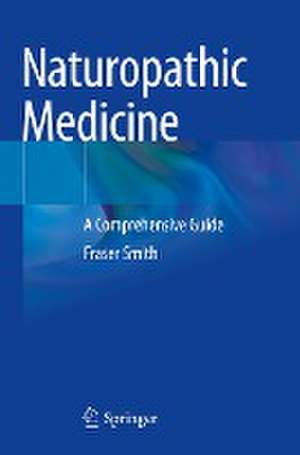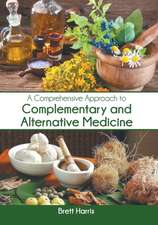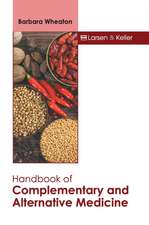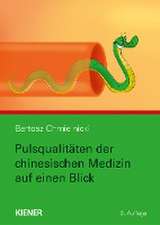Naturopathic Medicine: A Comprehensive Guide
Autor Fraser Smithen Limba Engleză Paperback – 29 oct 2023
There is a need for an approach in medicine that works to support adaptive responses of the body, reduce maladaptive responses, address determining factors of health, and sometimes create temporary homeostasis with agents such as drugs (or certain natural medicines) can play to maintain life when the body’s healing responses are insufficient. This book takes this approach and begins by examining what health is and then what states lead to disease. In terms of the basis of disease states, the book teaches about how the lack of coordination in the body’s bioregulatory systems (hormones, nervous system, cell signaling) can lead to disease, as well as the impact of irreversible degeneration, genetic damage, chronic stress, etc. The book takes the reader to some of the more common and well described reasons for these states of dysfunction, including the body’s inability to process environmental toxins and disruptions to the human microbiome. The book then teaches how to assess a patient, and how various natural therapies impact root causes of disease, the long term consequences, and the various clinical manifestations.
The book then takes a systems approach – cardiovascular, pulmonary, etc. This is where most books on the subject start, but instead of breaking out a number of conditions and giving protocols of diet, supplements, herbs etc., the author examines how to restore stability and function to that system. There is in depth coverage of how to confront degenerative processes that make self-healing far more challenging, or perhaps not entirely attainable. The application of the model of healing outlined in previous chapters is applied to each system. Special topics are then covered, ranging from lifespan/primary care considerations to the role of research, the rise of advanced data analytics as decision assistance, to the environmental, cultural, and global determinants of health. Each chapter will additionally include tables that summarize key diagnosis or treatment points, arrayed in an order that reflects the model presented in the book.
This is an ideal guide for students in naturopathic medicine, as well as physicians and medical professionals looking to learn more about this field aimed towards maximizing patient resilience.
| Toate formatele și edițiile | Preț | Express |
|---|---|---|
| Paperback (1) | 855.42 lei 43-57 zile | |
| Springer International Publishing – 29 oct 2023 | 855.42 lei 43-57 zile | |
| Hardback (1) | 1004.45 lei 38-44 zile | |
| Springer International Publishing – 29 oct 2022 | 1004.45 lei 38-44 zile |
Preț: 855.42 lei
Preț vechi: 900.45 lei
-5% Nou
Puncte Express: 1283
Preț estimativ în valută:
163.74€ • 177.91$ • 137.63£
163.74€ • 177.91$ • 137.63£
Carte tipărită la comandă
Livrare economică 21 aprilie-05 mai
Preluare comenzi: 021 569.72.76
Specificații
ISBN-13: 9783031133909
ISBN-10: 3031133900
Pagini: 518
Ilustrații: XXIII, 518 p. 113 illus., 106 illus. in color.
Dimensiuni: 155 x 235 mm
Greutate: 0.75 kg
Ediția:1st ed. 2022
Editura: Springer International Publishing
Colecția Springer
Locul publicării:Cham, Switzerland
ISBN-10: 3031133900
Pagini: 518
Ilustrații: XXIII, 518 p. 113 illus., 106 illus. in color.
Dimensiuni: 155 x 235 mm
Greutate: 0.75 kg
Ediția:1st ed. 2022
Editura: Springer International Publishing
Colecția Springer
Locul publicării:Cham, Switzerland
Cuprins
The nature of health, homeostasis, adaptation, biological plasticity, repair.- Disease (Theory of).- Where does a naturopathic approach apply?.- Causes of ill health.- Assessment of the patient.- Therapeutics.- States of ill health – assessment and overall mitigation.- Systems Approach to Therapy.- Life-span considerations.- Naturopathic medicine in context.- The role of research and scientific inquiry in naturopathic medicine.- The role of informatics and artificial intelligence in naturopathic medicine.- Societal, global, environmental impact that naturopathic physicians can have.- Appendix A: Recommended resources for clinical/scientific information.- Appendix B: Professional associations and public interest groups related to whole health, complementary and integrative medicine, naturopathic medicine, etc.
Notă biografică
Fraser Smith, MATD, ND is a professor at the National University of Health Sciences. He is a naturopathic physician and has taught, practiced, and written on this subject since 1997. He helped found the naturopathic medicine program at National University in Chicago area and serves as the Vice President of the North American Board of Naturopathic Examiners.
Textul de pe ultima copertă
This book offers comprehensive coverage of naturopathic medicine. The principles and values of this profession are already clearly stated (i.e., Find and Treat the Cause; Treat the Whole Person, etc.), but few are the textbooks that directly compare it to conventional or allopathic medicine. To paraphrase the historian of medicine Harris Coulter – in this approach the body reacts creatively to stressors – and the Empirical school or natural medicine approach is more focused on supporting adaptive responses than suppressing symptoms. This is not an attempt to argue that all health issues can get better on their own or that conventional medical interventions aren’t capable of producing stellar outcomes, but there remains a concurrent need for a naturopathic approach that helps rebuild the body.
This book presents an approach in medicine that works to support adaptive responses of the body, reduce maladaptive responses, address determining factors of health, and sometimes create temporary homeostasis with agents such as drugs (or certain natural medicines). In terms of the basis of disease states, the book teaches about how the lack of coordination in the body’s bioregulatory systems can lead to disease, as well as the impact of irreversible degeneration, genetic damage, chronic stress, etc. The book takes the reader to some of the more common and well described reasons for these states of dysfunction, how to assess a patient, and how various natural therapies impact root causes of disease, the long term consequences, and the various clinical manifestations. The book then takes a systems approach – cardiovascular, pulmonary, etc. This is where most books on the subject start, but instead of breaking out a number of conditions and giving protocols of diet, supplements, herbs etc., the author examines how to restore stability and function to that system. Special topics are then covered, ranging from lifespan/primary care considerations to the role of research, the rise of advanced data analytics as decision assistance, to the environmental, cultural, and global determinants of health. Each chapter will additionally include tables that summarize key diagnosis or treatment points, arrayed in an order that reflects the model presented in the book.
This is an ideal guide for students in naturopathic medicine, as well as physicians and medical professionals looking to learn more about this field aimed towards maximizing patient resilience.
This book presents an approach in medicine that works to support adaptive responses of the body, reduce maladaptive responses, address determining factors of health, and sometimes create temporary homeostasis with agents such as drugs (or certain natural medicines). In terms of the basis of disease states, the book teaches about how the lack of coordination in the body’s bioregulatory systems can lead to disease, as well as the impact of irreversible degeneration, genetic damage, chronic stress, etc. The book takes the reader to some of the more common and well described reasons for these states of dysfunction, how to assess a patient, and how various natural therapies impact root causes of disease, the long term consequences, and the various clinical manifestations. The book then takes a systems approach – cardiovascular, pulmonary, etc. This is where most books on the subject start, but instead of breaking out a number of conditions and giving protocols of diet, supplements, herbs etc., the author examines how to restore stability and function to that system. Special topics are then covered, ranging from lifespan/primary care considerations to the role of research, the rise of advanced data analytics as decision assistance, to the environmental, cultural, and global determinants of health. Each chapter will additionally include tables that summarize key diagnosis or treatment points, arrayed in an order that reflects the model presented in the book.
This is an ideal guide for students in naturopathic medicine, as well as physicians and medical professionals looking to learn more about this field aimed towards maximizing patient resilience.
Caracteristici
Comprehensively covers naturopathic medicine, including principles, values, and scientific underpinnings Focuses on the use of natural approaches to restore balance and function to underlying mechanisms Accessible to naturopathic medical students, practicing naturopathic physicians, and more





















